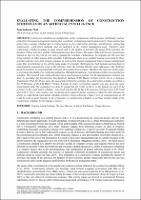Chapter Evaluating the Comprehension of Construction Schedules of an Artificial Intelligence
| dc.contributor.author | Sulbaran, Tulio | |
| dc.date.accessioned | 2024-04-02T15:45:51Z | |
| dc.date.available | 2024-04-02T15:45:51Z | |
| dc.date.issued | 2023 | |
| dc.identifier | ONIX_20240402_9791221502893_48 | |
| dc.identifier.issn | 2704-5846 | |
| dc.identifier.uri | https://library.oapen.org/handle/20.500.12657/89079 | |
| dc.description.abstract | Construction schedules are an important tool to communicate with the project stakeholders and are critical for the project management team to plan, coordinate, and manage construction projects. Each construction project has a unique schedule that is created based on the construction drawings, specifications, contracting requirements, construction methods, and the judgment of the project management team. Therefore, each construction schedule is unique in many aspects such as the number of activities, the names of the activities, the duration of those activities, and the relationship between the activities. The names of the activities are of particular interest as they are the critical core unit to creating the schedule. Furthermore, the activities are the ones that bring together all other aspects of the schedule. Unfortunately, there is no standard naming conversion for those activities and they vary from project to project as well as from project management team to project management team. This inconsistency of the activity name makes it extremely challenging for both humans and machines to understand the meaning and scope of the activities. Thus, the problem that this paper addresses is the challenge faced by machines to comprehend the activities of a construction schedule. Therefore, the objective of this paper is to evaluate the ability of an Artificial Intelligence (AI) implementation to comprehend activities in a construction schedule. This research was conducted following a mixed research method. The AI implementation training was done by providing the Construction Specifications Institute (CSI) Master Format activity list to a Sentence Transformer. Then the AI was given the task of interpreting the activities of a construction schedule according to the 50 Divisions of the CSI Master Format. A group of senior construction students was also given the same interpretation task. The evaluation was done by comparing the results of the AI vs the humans for each of the activities in the construction schedule. The result was that the AI has 0.56 accuracy, 0.50 precision, 0.85 recall and, 0.64 F1 Score. This result is very promising and it supports further research to refine the AI to increase its ability to comprehend construction schedule activities. Upon achieving a higher level of comprehension an AI could be used to assist humans in the preparation of construction schedules or perhaps prepare drafts of the construction schedules for the human to review | |
| dc.language | English | |
| dc.relation.ispartofseries | Proceedings e report | |
| dc.subject.classification | thema EDItEUR::U Computing and Information Technology::UY Computer science::UYQ Artificial intelligence | |
| dc.subject.other | Construction Scheduling | |
| dc.subject.other | Decision Support | |
| dc.subject.other | Artificial Intelligence | |
| dc.subject.other | Comprehension | |
| dc.title | Chapter Evaluating the Comprehension of Construction Schedules of an Artificial Intelligence | |
| dc.type | chapter | |
| oapen.identifier.doi | 10.36253/979-12-215-0289-3.53 | |
| oapen.relation.isPublishedBy | bf65d21a-78e5-4ba2-983a-dbfa90962870 | |
| oapen.relation.isbn | 9791221502893 | |
| oapen.series.number | 137 | |
| oapen.pages | 8 | |
| oapen.place.publication | Florence |

